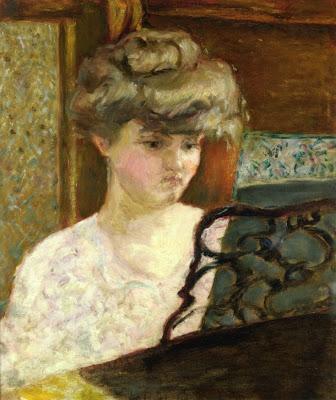 Pierre Bonnard
Pierre Bonnard Pierre Bonnard
Pierre Bonnard Edouard Vuillard
Edouard VuillardIn 1900 Misia was a voluptous 28 years old. The Paris Exposition was on. Misia was about to lose her good friend Toulouse-Lautrec. Her husband, Thadée Natanson, began taking more of an interest in politics. He found le Revue Blanche boring and entered into new and not-so-lucrative ventures. And the newspaper magnate Alfred Edwards fanatically pursued Misia like Pépé le Pew pursued the little black and white cat.
 Photo of Misia and Thadée by Edouard Vuillard
Photo of Misia and Thadée by Edouard VuillardMisia was offended and a little afraid of the extremely boorish, powerful Edwards. Misia’s husband found her attitude childish and urged her to use her charm to secure financial backing from him.
His plan backfired. Alfred Edwards did in fact help ease Thadée Natanson's financial woes, but Edwards was so obsessed with Misia that having her as a mistress was not enough. He wanted her as his wife. The fact that he already had a wife didn’t seem to matter.
 Alfred Edwards
Alfred EdwardsOnce again Thadée had bungled his affairs. He resigned himself to the situation between Edwards and his wife and cabled Misia to “arrange everything.” Misia now saw Thadée as a tarnished knight - Edwards as the dragon. Perhaps by marrying the dragon she would no longer need protection. Misia began to feel “the agitation which strongly resembles love”. She began living with Alfred Edwards in 1903 and married him a few years later.
Misia acquired new friends in the Parisian musical and artistic circles. She was a confidante of Pablo Picasso and Jean Cocteau and an early and devoted patron of Sergei Diaghilev's Ballets Russes. She was an inspiration to Proust and Apollinaire.
Maurice Ravel dedicated "Le Cygne" to her. When Ravel failed for the third time to win the Prix de Rome, Misia used her new husband’s clout to make the director of the Conservatoire resign. Gabriel Fauré, Misia’s childhood piano teacher took over the postion.
Misia played the piano for Caruso while he sang Neapolitan songs, and told him to pipe down when she’s had enough.
Misia was a close friend of designer Coco Chanel. Coco said "Misia never read a book"; however, she was always surrounded by people who were pure culture.”
Many of her friends from the old days stayed close and at least one grew even closer. Renoir didn’t pick sides. He was a deeply moral man and approved of Misia’s gift for bringing life alive.
Renoir longed to paint Misia’s famous breasts naked, but she would never bare them, probably because Edwards was lurking jealously despite the fact that Renoir was badly crippled with arthritis. Misia once rewarded Renoir for a portrait by giving him a blank check. He filled it out with the going rate. Apparently Renoir wrote love letters to her, but on the advice of her literary agent, deeming them as “too silly”, Misia destroyed them before her death.
 Misia by Renoir
Misia by RenoirMisia lost Edwards to the gorgeous actress Genevieve Lantelme. As the break-up took a long time Misia was able to continue enjoying a large income. In the early stages of the breakup she headed for the coast to get away from it all. Marcel Proust was on hand to observe that Misia had ended up sharing a stretch of beach with her husband and his new mistress and her ex-husband Thadée.
More to come. (including a third husband)

